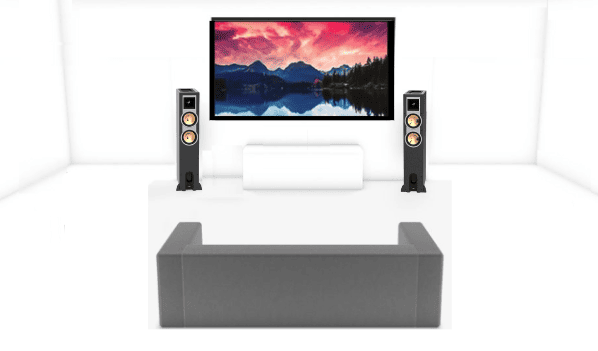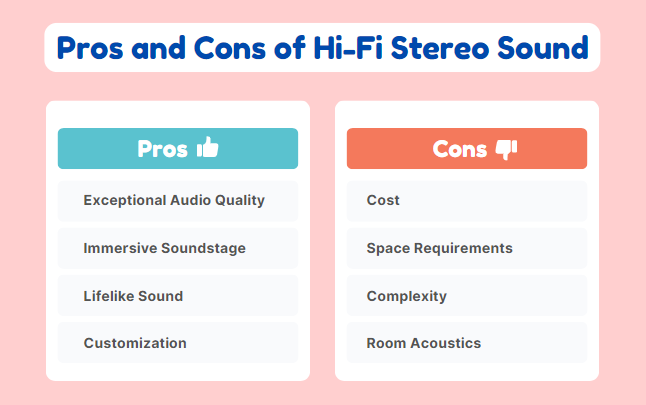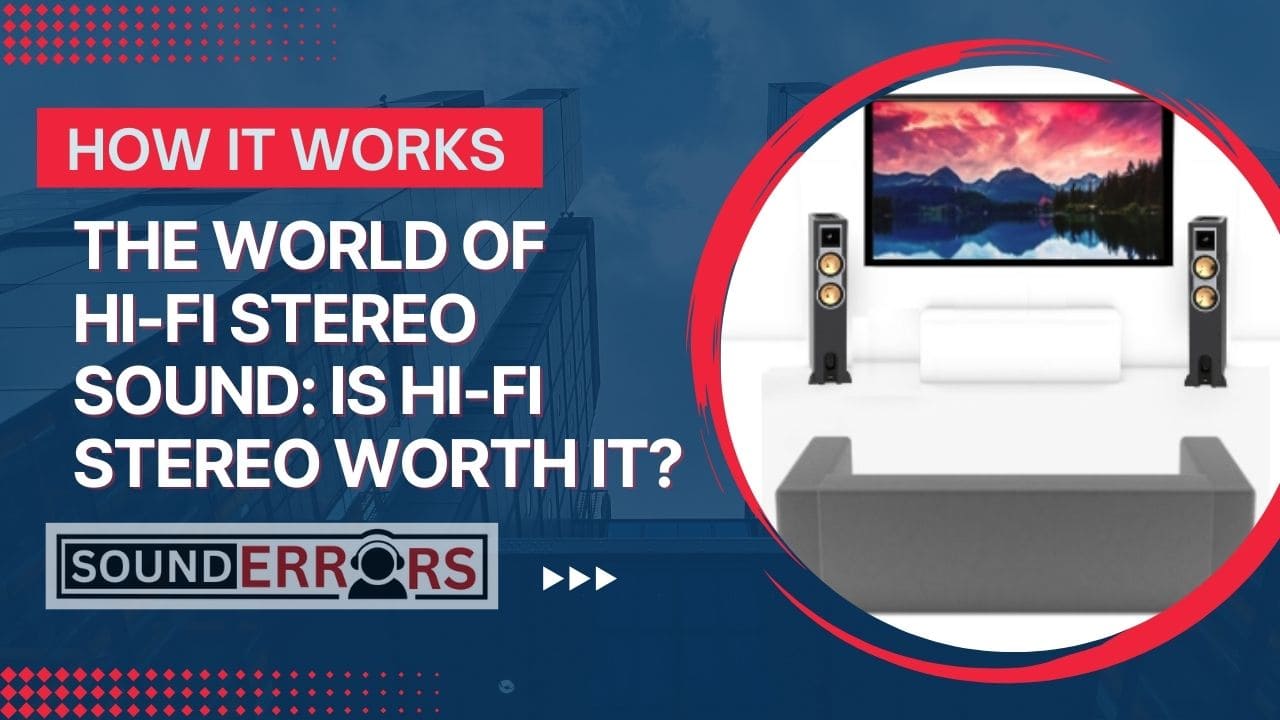This Post may contain affiliate links, when you purchase through links on our site, we may earn an affiliate commission at no extra cost to you. Here’s how it works.
Whether you’re an audiophile or casual listener who appreciates a richer, more immersive listening experience, Hi-Fi stereo sound can give you another level of audio experience.
Table of Contents
ToggleMany listeners still don’t know about Hi-Fi stereo sound and how it works, or whether it’s worth investing in.
What is Hi-Fi Stereo Sound?
Hi-Fi stands for High Fidelity, which refers to reproducing sound as close as possible to the original recording. The term “stereo” simply refers to audio that uses two or more channels to create a sense of space and directionality, making the listening experience more immersive.
Hi-Fi stereo sound systems aim to reproduce the music with minimal distortion and noise. This is achieved through equipment such as amplifiers, speakers, and sources, that preserve the integrity of the sound.

How Hi-Fi Stereo Sound Works?
Hi-Fi stereo sound systems consist of multiple components that deliver top-notch audio. Here’s a breakdown of the basic components and how they contribute to the sound experience:
- Audio Source: The source is where your audio originates, whether it’s a digital file such as FLAC, WAV, or CD. The quality of the source material is crucial. Low-quality sources can compromise the overall sound quality.
- Amplifier: The amplifier boosts the audio signal to a level that can drive the speakers. A Hi-Fi amplifier is designed to do this cleanly and ensure that the audio signal remains true to the original.
- Speakers: The speakers convert the amplified electrical signal into sound waves. High-end Hi-Fi speakers are designed to produce a balanced, natural sound across all frequencies.
- Wiring and Connectivity: Quality cables and connectors help the signal remain as pure as possible from the source to the speakers. Poor-quality cables can introduce noise and degrade the sound quality.
- Acoustic Environment: Even the best Hi-Fi system can be affected by its surroundings. Sound waves bounce off walls, furniture, and other surfaces and play a crucial role in how audio is perceived. Using bass traps and sound absorber panels can solve this issue.
By combining these elements Hi-Fi stereo sound systems strive to produce the clearest, most accurate reproduction of the original audio. This audio technology is used in home theater, gaming, etc.
Is Hi-Fi Stereo Sound Worth It?
If you’re passionate about audio quality investing in a Hi-Fi stereo sound system can be a game-changer. However, whether it’s “worth it” depends on your personal preferences, budget, and listening habits. Here are some factors to consider:
- Audio Quality: Hi-Fi stereo sound offers exceptional clarity, detail, and balance, especially when compared to lower-quality or budget audio systems. The difference can be especially noticeable in classical, jazz, or high-resolution digital formats.
- Listening Experience: Hi-Fi stereo setup provides an immersive experience. The precise soundstage, accurate frequency response, and enhanced dynamics can make you feel like you’re in the live action.
- Longevity: High-quality Hi-Fi systems tend to have a long lifespan, and many audiophiles see them as a long-term investment. For me, it’s all about the brands you choose.
- Cost: Hi-Fi stereo sound systems can be expensive, and the investment goes beyond just buying speakers or an amplifier. You might need to invest in room treatment and cables. For me, the price tag is too high, especially when other budget options provide a decent listening experience.
In the end, I will say, that if you have the budget for it and looking for high-end audio quality this is for you. Big no, if you have a decent budget (other option available) and for a casual listener.
Pros and Cons of Hi-Fi Stereo Sound
Like any technology, Hi-Fi stereo sound systems come with their set of advantages and potential drawbacks. Here’s a quick overview of the pros and cons:

Pros of Hi-Fi Stereo Sound
- Exceptional Audio Quality: Hi-Fi systems provide a level of clarity, precision, and detail that you won’t find in lower-end systems.
- Immersive Soundstage: With precise stereo imaging and accurate speaker placement, Hi-Fi stereo sound creates a sense of space, making it feel like the music is coming from all around you.
- Lifelike Sound: Hi-Fi systems can reproduce audio with remarkable fidelity, bringing out nuances that would be lost in lower-quality setups.
- Customization: Audiophiles enjoy customizing their Hi-Fi systems to suit their preferences, whether it’s adjusting the sound signature with different speakers, amplifiers, or source materials.
Cons of Hi-Fi Stereo Sound
- Cost: Hi-Fi systems are typically more expensive than standard consumer audio equipment, and getting a truly high-end setup can cost thousands of dollars.
- Space Requirements: To achieve the best sound quality, Hi-Fi stereo setups usually require more space and careful placement. This can be a challenge for people with smaller living spaces.
- Complexity: The sheer number of components and setup options can be overwhelming for newcomers. Achieving the perfect sound requires a bit of technical knowledge and patience.
- Room Acoustics: Even the best Hi-Fi Stereo system can be affected by poor room acoustics. To get the most out of your system, you may need to invest in room treatment, which can add to the cost.
What’s the Difference Between Hi-Fi and Stereo Sound?
Stereo sound refers to two or more channels (left and right) to create an immersive listening experience, and “Hi-Fi” refers to the accuracy of that sound. In other words, stereo sound is about the spatial aspect of the audio, while Hi-Fi sound is about how faithfully the audio is reproduced.
Here’s a quick comparison:
- Stereo Sound: Refers to multiple speakers to create a sense of direction and space in the sound. It can be achieved with basic, budget-friendly equipment.
- Hi-Fi Sound: Refers to the quality of the sound reproduction. Hi-Fi systems are designed to minimize distortion, noise, and other imperfections to provide an audiophile-quality experience. A Hi-Fi stereo system combines both high-quality sound reproduction and stereo imaging.
Conclusion:
Hi-Fi stereo sound is ideal for those who are looking for the highest level of audio quality. It offers improvement over standard stereo sound systems, with more detail, clarity, and accuracy. However, it comes at a cost, both in terms of money and time spent on setting up the perfect system.
For audiophiles, the investment is often well worth it, as per sound quality. But if you’re just casually listening to music, a mid-range system may suffice, there are many options available to use. However, for those who truly appreciate music or film, Hi-Fi stereo sound offers a listening experience that can make every note come alive.
